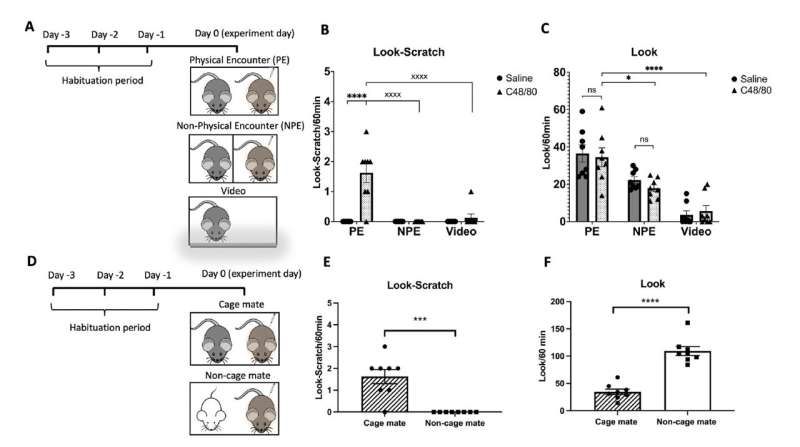June 7, 2024 feature
This article has been reviewed according to Science X's editorial process and policies. Editors have highlighted the following attributes while ensuring the content's credibility:
fact-checked
peer-reviewed publication
trusted source
proofread
Study finds social interactions and olfactory cues prompt contagious itch in mice

Humans and other mammals can sometimes experience itch, an uncomfortable sensation that prompts them to scratch specific parts of their bodies. Past studies on humans and other primates have found that itch can sometimes be contagious.
For instance, some experiments showed that some sounds or videos related to scratching can induce an itch in humans. Others showed that people could also feel itchy or scratched after discussing scratching-related topics with peers.
Similarly, when watching another monkey scratching, whether in person or in video footage, monkeys were found to also engage in scratching behaviors. Some research works have also been trying to determine if contagious scratching also occurs in mice and what type of stimuli prompt this behavior.
Researchers at Tehran University of Medical Sciences recently found that contagious itch only occurs in mice when they observe if a mouse that has been in their proximity (i.e., their cage-mate) is scratching. Their findings, published in Scientific Reports, show that social interactions and olfactory cues are necessary for mice to exhibit contagious itch.
"The phenomenon of contagious itch, observed in both humans and rodents, remains a topic of ongoing debate concerning its modulators and underlying pathways," Maryam Shayan, Nazgol-Sadat Haddadi and their colleagues wrote in their paper. "This study delves into the relationship between contagious itch and familiar olfactory cues, a non-visual factor contributing to this intriguing behavior."
The experiments carried out by Shayan, Haddadi and their colleagues involved a total of 272 male mice aged between 5 and 6 weeks. The mice were first checked for any skin problems that could potentially cause itch, confounding the results, and then placed into separate acrylic boxes with bedding in them for 30 minutes every day in the three days leading up to the experiment.
During the experiment, two mice were placed in the same box and one of them was injected with a compound that caused temporary itching. The team observed and recorded the mice's behavior to determine if, when one mouse started scratching, their cagemate emulated this behavior.
Notably, some of the paired mice had physical contact with their cagemate during the experiment, while others did not. Mice in the non-physical encounter condition were separated from the other mice in their respective pair with a perforated transparent plastic layer that only allowed them to pick up visual, olfactory and auditory cues, without engaging in social interactions.
"Our findings showed that contagious itch in observer mice occurs during physical interaction with the cagemate itch-demonstrator but not with a stranger demonstrator or in a non-physical encounter condition," Shayan, Haddadi and their colleagues wrote.
"Notably, itch-experienced observer mice displayed an increased contagious itch behavior, highlighting the relevance of itch-associated memory in this phenomenon. Furthermore, anosmic observer mice, whether itch-naïve or itch-experienced, displayed no contagious itch behavior."
The researchers also found that the mice's brain activity corresponded to the behavior they observed. Specifically, they observed an increase in activity in the olfactory bulb while mice engaged in contagious itch behavior, amygdala, hypothalamus and hippocampus, brain regions that have been linked to olfaction, emotion and memory. This activity instead diminished in mice that were anosmic (i.e., temporarily unable to pick up odors).
Overall, the team's findings suggest that for mice to exhibit contagious itch behaviors, they need to both be exposed to familiar olfactory cues (i.e., the body odors permeating from the scratching cagemate) and be able to socially interact with the itchy mouse. These observations contribute to the understanding of contagious itch in different mammals and could inform new studies exploring this phenomenon in mice.
Shayan, Haddadi and their colleagues wrote, "In conclusion, our study unveils the critical role of familiar olfactory cues in driving contagious itch in mice, shedding light on the interplay between social factors, sensory perception, and memory in this phenomenon."
More information: Shayan, M. et al. Social interactions and olfactory cues are required for contagious itch in mice. Scientific Reports(2024). DOI: 10.1038/s41598-024-61078-3.
© 2024 Science X Network


















